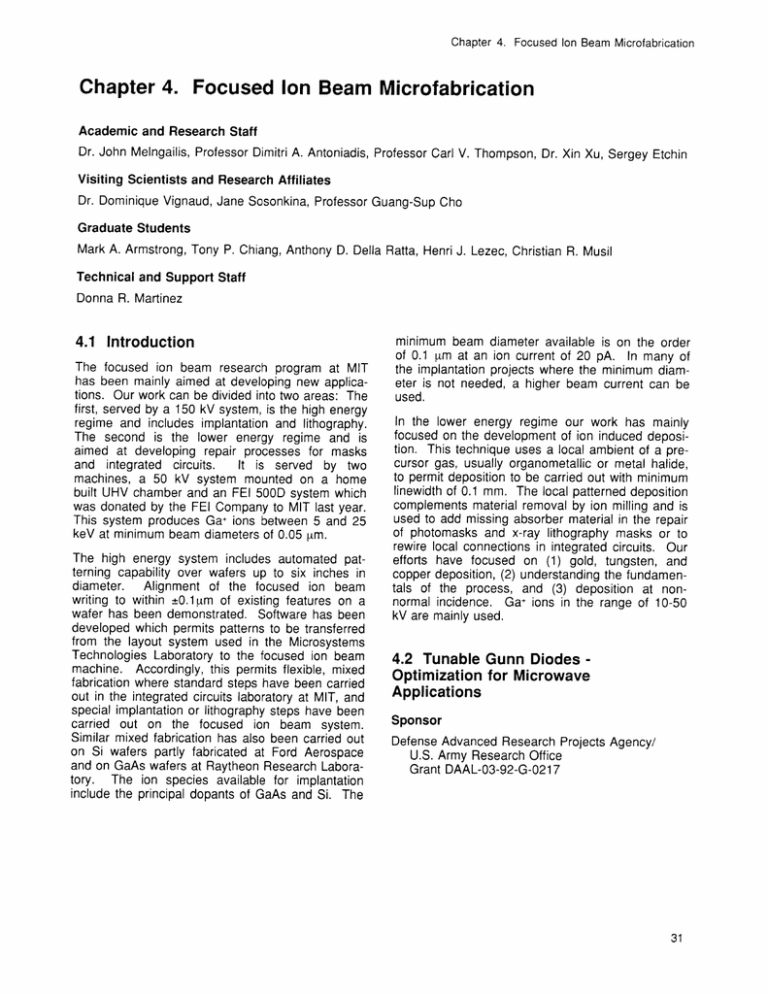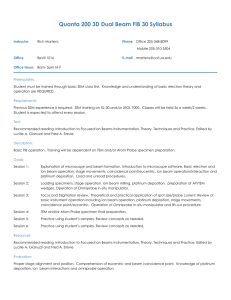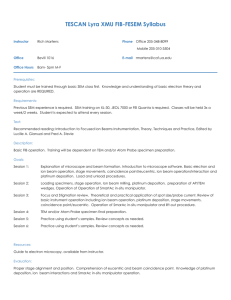Chapter 4. Focused Beam Microfabrication Ion
advertisement

Chapter 4. Focused Ion Beam Microfabrication Chapter 4. Focused Ion Beam Microfabrication Academic and Research Staff Dr. John Melngailis, Professor Dimitri A. Antoniadis, Professor Carl V. Thompson, Dr. Xin Xu, Sergey Etchin Visiting Scientists and Research Affiliates Dr. Dominique Vignaud, Jane Sosonkina, Professor Guang-Sup Cho Graduate Students Mark A. Armstrong, Tony P. Chiang, Anthony D. Della Ratta, Henri J. Lezec, Christian R. Musil Technical and Support Staff Donna R. Martinez 4.1 Introduction The focused ion beam research program at MIT has been mainly aimed at developing new applications. Our work can be divided into two areas: The first, served by a 150 kV system, is the high energy regime and includes implantation and lithography. The second is the lower energy regime and is aimed at developing repair processes for masks and integrated circuits. It is served by two machines, a 50 kV system mounted on a home built UHV chamber and an FEI 500D system which was donated by the FEI Company to MIT last year. This system produces Ga+ ions between 5 and 25 keV at minimum beam diameters of 0.05 tm. The high energy system includes automated patterning capability over wafers up to six inches in diameter. Alignment of the focused ion beam writing to within -±0.1im of existing features on a wafer has been demonstrated. Software has been developed which permits patterns to be transferred from the layout system used in the Microsystems Technologies Laboratory to the focused ion beam machine. Accordingly, this permits flexible, mixed fabrication where standard steps have been carried out in the integrated circuits laboratory at MIT, and special implantation or lithography steps have been carried out on the focused ion beam system. Similar mixed fabrication has also been carried out on Si wafers partly fabricated at Ford Aerospace and on GaAs wafers at Raytheon Research Laboratory. The ion species available for implantation include the principal dopants of GaAs and Si. The minimum beam diameter available is on the order of 0.1 m at an ion current of 20 pA. In many of the implantation projects where the minimum diameter is not needed, a higher beam current can be used. In the lower energy regime our work has mainly focused on the development of ion induced deposition. This technique uses a local ambient of a precursor gas, usually organometallic or metal halide, to permit deposition to be carried out with minimum linewidth of 0.1 mm. The local patterned deposition complements material removal by ion milling and is used to add missing absorber material in the repair of photomasks and x-ray lithography masks or to rewire local connections in integrated circuits. Our efforts have focused on (1) gold, tungsten, and copper deposition, (2) understanding the fundamentals of the process, and (3) deposition at nonnormal incidence. Ga ions in the range of 10-50 kV are mainly used. 4.2 Tunable Gunn Diodes Optimization for Microwave Applications Sponsor Defense Advanced Research Projects Agency/ U.S. Army Research Office Grant DAAL-03-92-G-0217 Chapter 4. Focused Ion Beam Microfabrication Project Staff Christian R. Musil, Henri J. Lezec, Sergey Etchin, Leonard J. Mahoney,' Alex Chu, 2 Professor Dimitri A. Antoniadis, Dr. John Melngailis Tunable Gunn diodes are two-terminal voltage controlled oscillators (VCOs). They are fabricated by using a focused ion beam to implant a gradient of doping in the direction of current flow. The best performance we have achieved so far is tunability over 20 GHz with a maximum frequency of 42 GHz. To optimize the performance, we have recently implanted a large array of devices (over 3000) varying the dose, geometry, and gradient as parameters. An immediate application of these simple VCOs is the built-in-test for monolithic microwave integrated circuits (MMICs). A tunable Gunn diode is coupled to the input, and a diode detector is coupled to the output. By switching these two elements into the circuit and applying a ramp bias signal to the Gunn diode, the circuit is tested by varying the frequency of the input signal over its entire range of operation. 4.3 Dose Rate Effects in the Implantation of Si in GaAs Sponsor Defense Advanced Research Projects Agency/ U.S. Army Research Office Grant DAAL03-92-G-0217 Project Staff 3 Christian R. Musil, Tony E. Haynes, Sergey Etchin, Professor Dimitri A. Antoniadis, Dr. John Melngailis The instantaneous current density of a focused ion 2 beam is of order 0.1 to 1 A/cm . In normal, broad density is 4 to 6 current the beam implantation orders of magnitude lower. We have shown that this high instantaneous current density can lead to increased lattice damage in some cases of focused ion beam implantation. One way to mitigate these effects is to scan the beam over the sample so as to present a lower average current density. We have found surprising effects of a large variations in lattice damage as a function of the scan rate of the focused ion beam. At a given point on the substrate the scan schedule produces a pulsed implant 1 MIT Lincoln Laboratories. 2 MITRE Corporation, Bedford, Massachusetts. 3 32 Oak Ridge National Laboratory. RLE Progress Report Number 135 of a selected dwell time which is repeated after We have measured the damage some period. using Rutherford backscattering as well as electrical properties. At a given dwell time, for example, the amount of damage decreases for repetition periods up to times of order seconds. This implies that, contrary to one's intuition, after an ion (Si) has penetrated into the solid (GaAs), it does not come into equilibrium even after one second. In general, the lattice would be expected to be back in equilibrium in times of order nanoseconds. 4.4 Limited Lateral Straggle of Focused-Ion-Beam Implants Sponsor Defense Advanced Research Projects Agency/ U.S. Army Research Office Grant DAAL03-92-G-0217 Project Staff Dr. Dominique Vignaud, Christian R. Musil, Sergey Etchin, Professor Dimitri A. Antoniadis, Dr. John Melngailis The lateral straggle of ions as they penetrate into a substrate limits the minimum lateral dimensions of implant profiles that can be defined in a substrate. This potential spreading of the profile has to be considered to fabricate devices at ultrasmall dimensions or confined carrier structures for quantum effect studies. The lateral distribution of focusedion-beam implanted Si and Be atoms has been studied by measuring the electrical resistivity in grating structures. The gratings which were oriented perpendicular to the direction of the current flow were implanted with silicon and beryllium at They were 280 and 260 keV respectively. implanted into semi-insulating materials cut on- and The off-axis, and then repaid-thermal-annealed. lateral straggle was found to be less than 100 nm for Si and equal to 190 nm for the Be implants. The standard deviation of the lateral distribution was found to increase with the dose. This is attributed to a concentration-dependent diffusion which results in an anomalously high diffusion coefficient. Comparison of the experimental parameters of the implanted distribution with values found in standard tables or calculated by a Monte-Carlo TRIM code Chapter 4. Focused Ion Beam Microfabrication seems to indicate that all simulations overestimate lateral straggle at the expense of penetration depth. focused ion beam implant and, in some circumstances, may justify the cost in implantation time. 4.5 Focused Ion Beam Implantation in GaAs for Transistor Optimization 4.6 Confined Carrier Distributions in Ill-V Semiconductors Created by Focused Ion Beams Sponsor National Science Foundation Grant ECS 89-21728 Sponsor Project Staff Defense Advanced Research Projects Agency/ U.S. Army Research Office (ASSERT Program) Grant DAAL03-92-G-0305 T.E. Kazior,4 M.H. Cobb,4 Sergey Etchin, Dr. John Melngailis Project Staff Focused ion beam implantation is a useful technique for optimizing channel implants in integrated circuits. The fact that the implants are done in a maskless, direct-write fashion permits the dose, ion energy, and ion species to be varied from device to device on the same wafer. Wafer to wafer variations do not obscure interpretation of the data. To demonstrate this, we have implanted the Be buried p-layer beneath the active Si-implanted channel in a GaAs MESFET. The Be and Si implant conditions were varied over a range of energies and doses. The optimum performance is expected for implant conditions which yielded the steepest gradient in the tail of the electron concentration profile without producing conducting holes. All implants were performed through a 50 nm SiNx film and rapid thermal annealed at 9000C for 10 seconds. The transistor gates were 0.25 im long with a T-shaped profile. Within the range of Be implant conditions explored, the gradient in the tail of the electron distribution was strongly dependent on the dose, but did not vary systematically with changes in energy. The experiments carried out on a single wafer indicate that a large process window exists for the Be implant parameters and this results in an improved 10 GHz noise performance. This type of optimization with conventional broad beam implants would require an unacceptable number of wafers and would be complicated by wafer to wafer variations. These results also show that focused ion beam implantation could be useful as a production technique if a given integrated circuit required a large variety of implants, each one over a limited area. In conventional fabrication, each implant requires a complete sequence of steps (resist spinning, exposure, development, broad beam implantation, and resist stripping). These steps are eliminated by the 4 Raytheon Research Laboratory, Lexington, Massachusetts. Mark A. Armstrong, Professor Dimitri A. Antoniadis, Dr. John Melngailis One way to obtain confined carrier distributions for quantum effect studies is to use focused ion beam implantation damage. In particular, the insulating region produced by the damage can be used to carve up the two-dimensional electron gas produced by modulation doping. One of the effects which may limit the resolution of this technique is the depletion of carriers around the implanted region. We are attempting to calculate the effect of this depletion by using analogies to the widely studied and modeled Si/SiO 2 interface in MOS structures. The width of the depletion will also be measured by writing different geometries to create planar capacitors and transistors in GaAs/AIGaAs mesas. 4.7 Focused Ion Beam Lithography for X-ray Mask Making Sponsor Semiconductor Research Corporation Project Staff Tony P. Chiang, Sergey Etchin, Dr. John Melngailis Making an x-ray mask is a challenging task. The absorber material on the thin mask membrane must be fabricated of high Z material (e.g., Au or W) with high aspect ratio, (e.g., 0.25 to 0.5 pm thick at minimum dimensions down to 0.1 [m). Two techniques for writing the original pattern of the mask in resist are electron beam lithography and focused ion beam lithography. While electron beams have been extensively developed and applied, ion beams Chapter 4. Focused Ion Beam Microfabrication have been used to write patterns down to 0.015 tm minimum linewidth and show no proximity effects even for resists over high Z material. The resist exposure times for the two techniques are comparable. Previously, we had fabricated x-ray masks at MIT with minimum linewidth of 0.05 m in absorber 0.2 llm thick. One goal of this program is to fabricate x-ray masks for use at the Center for X-ray Lithography at the University of Wisconsin. The absorber material must be 0.5 im thick because of the higher energy of the x-ray photons used. Thus the resist (PMMA) thickness in this case has to be of order 0.6 m, and the lithography is more challenging to accomplish. The masks are fabricated by exposing the PMMA over a thin gold plating base, writing the pattern with either Be- + or Si- ions at 260 keV, developing the resist, and plating up the gold absorber features. We have determined the optimum ion exposure dose, developing conditions and plating conditions. In test structures we have succeeded in producing gold features with 0.1 tm lines 0.5 im high. In the Prometrix test pattern which was successfully delivered to the University of Wisconsin the minimum lines written were 0.2 im wide. 4.8 Focused Ion Beam Induced Deposition of Copper U.S. Army Research Office Grant DAAL93-90-G-0223 U.S. Navy - Naval Research Laboratory/Micrion Contract M08774 National Science Foundation Grant DMR 92-02633 U.S. Army Research Office Grant DAAL03-90-G-0223 Project Staff Dr. Xin Xu, Anthony D. Della Sosonkina, Dr. John Melngailis Project Staff Carl V. Focused ion induced deposition is used in the repair of integrated circuits and masks. For the repair of circuits, a low resistivity of the deposited material is desirable. In the deposition process a local ambient of an organometallic gas is formed on the surface where the ion beam is incident. The incident ions cause the adsorbed molecules to be decomposed, leaving the metal, and usually some carbon, deposited on the surface. Typically the resistivity of the film is in the 100-1000 iQcm range, compared to 1-10 iQcm for pure metals. We have achieved the first focused ion beam deposition of copper from a novel organometallic precursor gas, Cu (hfac) TMVS. Ga ions at 35 keV 34 RLE Progress Report Number 135 4.9 Focused Ion Beam Induced Deposition and Ion Milling as a Function of Angle of Ion Incidence Sponsors Sponsors Anthony D. 'Della Ratta, Professor Thompson, Dr. John Melngailis were used. Resistivity and yield have been measured as a function of temperature and average ion current density. Submicron copper lines deposited at room temperature from this precursor exhibit resistivities as low as 70 tQcm; a sharp drop in these values is noted for deposition at 700C, and deposition on a substrate heated above about 1000C yields resistivities near those of pure bulk copper. Composition analysis by Auger Electron Spectroscopy shows the high temperature deposition to be nearly pure copper. Deposition yields of 25 copper atoms per incident Ga+ ion have been obtained on both silicon and silicon dioxide substrates, with growth rates of up to 13 A per second at an average ion current density of 200 tA/cm 2 The microstructure of the film will be examined by scanning electron microscopy (SEM) and transmission electron microscopy (TEM). The precursor shows special promise for the deposition of low resistivity submicrometer interconnects on integrated circuits. Ratta, Jane In the repair of integrated circuits, x-ray masks focused ion beam induced deposition and ion milling often have to be performed over quite nonplanar topography. Thus, the milling and the deposition as a function of the angle of ion incidence are important. The milling yield of Si, SiO 2 , Au, and W versus angle of incidence using 25 keV Ga+ ions has been measured. In qualitative agreement with simulations, the yield rises with angle and then falls as grazing incidence is approached. Deposition yield versus angle was measured using dimethylgold hexafluoro-acetylacetonate and W (CO) 6 as the precursor gases. The measurements were carried out using cylindrical quartz fibers 30-50 im in diameter which automatically provide a range of angles. Rippling of the deposited material is observed at angles of incidence greater than 500. Chapter 4. Focused Ion Beam Microfabrication 4.10 Publications Chu, A., H.M. Cronson, J.F. Devine, S. Soares, M.N. Solomon, H.J. Lezec, and C.R. Musil. "RF Built-In Test and Enabling Technologies for Integrated Diagnostics." Paper presented at the IEEE Systems Readiness and Automatic Testing Conference, Dayton, Ohio, September 21-24, 1992. Ehrlich, D.J., R.R. Kunz, M.A. Hartney, M.W. Horn, and J. Melngailis. "New Photoresist Processes at UV Wavelengths Less Than 200 nm." In Irradiation of Polymeric Materials. Eds. E. Reichmanis, O'Donnel, and Frank. ACS Symposium Series, vol. 527. Forthcoming. Kunz, R., D.J. Ehrlich, J. Melngailis, and M.W. Horn. "Selective Area Growth of Metal Oxide Films Induced by Patterned Excimer Laser Surface Photolysis." Proc. Mat. Res. Soc. Symp. 236: 105 (1992). Lattes, A.L., S.C. Munroe, M.M. Seaver, J.E. Murguia, and J. Melngailis. "Improved Drift in Two-Phase, Long-Channel, Shallow-BuriedChannel CCDs with Longitudinally Nonuniform Storage-Gate Implants." IEEE Trans. Electron Devices 39: 1772 (1992). Melngailis, J. "Focused Ion Beam Lithography." Invited plenary paper at the International Conference on the Ion Beam Modification of Materials, Heidelberg, Germany September 1-11, 1992. Nucl. Instrum. Methods Phys. Res. Forthcoming. Vignaud, D., S. Etchin, K.S. Liao, C.R. Musil, D.A. Antoniadis, and J. Melngailis. "Lateral Straggle of Focused-Ion-Beam Implanted Be in GaAs." Appl. Phys. Lett. 60: 2267 (1992). Vignaud, D., C.R. Musil, S. Etchin, D.A. Antoniadis, and J. Melngailis. "Lateral Straggle of Si and Be Focused-lon-Beam-Implanted in GaAs." J. Vac. Sci. Technol. Forthcoming. Xu, X., A.D. Della Ratta, J. Sosonkina, and J. Melngailis. "Focused Ion Beam Induced Deposition and Ion Milling as a Function of Angle of Incidence." Paper presented at the International Symposium on Electron, Ion, and Photon Beams, Orlando, Florida, May 26-31, 1992. J. Vac. Sci. Technol. B 10: 2675 (1992). Thesis Lezec, H.J. Tunable-Frequency Gunn Diodes Fabricated by Focused Ion-Beam Implantation. Ph.D. diss., Dept. of Electr. Eng. and Comput. Sci., MIT, 1992. 36 RLE Progress Report Number 135






